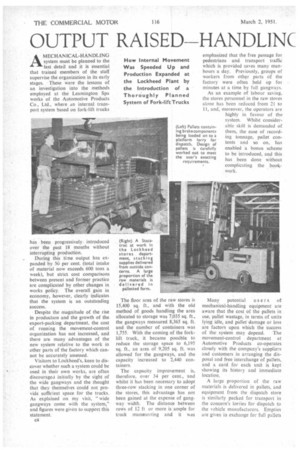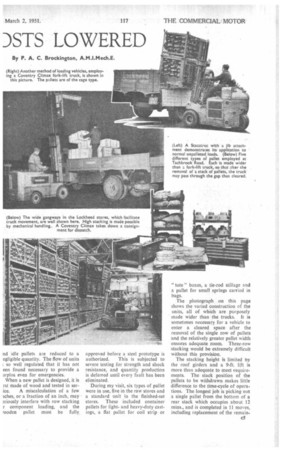OUTPUT RAISED HANDLINC )STS LOWERED
Page 42

Page 43

Page 44

If you've noticed an error in this article please click here to report it so we can fix it.
By P. A. C, Brockington, A.M.I.Mech.E.
AMECHANICAL-HANDL1NG system must be planned to the last detail and it is essential that trained members of the staff supervise the organization in its early stages. These were the lessons of an investigation into the methods employed at the Leamington Spa works of the Automotive Products Co., Ltd., where an internal transport system based on fork-lift trucks has been progressively. introduced over the past 18 months without interrupting production.
During this time output has expanded by 50 per cent. (total intake of material now exceeds 600 tons a week), but strict cost comparisons between present and former practice are complicated by other changes in works policy. The overall gain in economy, however, clearly indicates that the system is an outstanding success.
• Despite the magnitude of the rise in production and the growth of the export-packing department, the cast of running the movement-control organization has not increased, and there are many advantages of the new system relative to the work in other parts of the factory which cannot be accurately assessed.
Visitors to Lockheed's, keen to discover whether such a system could be used in their own works, are often discouraged initially by the sight of the wide gangways and the thought that they themselves could not provide sufficient space for the trucks. As explained on my visit, "wide gangways come with the system," and figures were given to support this statement.
c4 The floor area of the raw stores is 15,400 sq. ft., and with the old method of goods handling the area allocated to storage was 7,035 sq. ft., the gangways measured 8,365 sq. ft. and the number of containers was 1,755. With the coming of the forklift truck, it became possible to reduce the storage space to 6,195 sq. ft., an area of 9,205 sq. ft. was allowed for the gangways, and the capacity increased to 2,440 containers.
The capacity improvement is, therefore, over 34 per cent., and whilst it has been necessary to adopt three-row stacking in one corner of the stores, this advantage has not been gained at the expense of gangway width. The distance between rows of 12 ft or more is ample for truck rnanceuvring and it was emphasized that the free passage for pedestrians and transport traffic which is provided saves many manhours a day. Previously, groups of workers from other parts of the factory were often held up for minutes at a time by full gangways.
As an example of labour saving, the stores personnel in the raw stores alone has been reduced from 21 to 11, and, moreover, the operators are highly in favour of the system. Whilst considerable skill is demanded of them, the ease of recording tonnage, pallet contents and so on, has enabled a bonus scheme to be introduced, and this has been done without complicating the bookwork.
•
Many potential users of mechanical-handling equipment are aware that the cost of the pallets in use,pallet wastage, in terms of units lying idle, and pallerdamage or loss are factors upon which the success
of the system may depend. The movement-control department at Automotive Products, co-operates closely with the company's suppliers and customers in arranging the disposal and free interchange of pallets, and a card for each unit is kept showing its history and immediate location.
A large proportion of the raw materials is delivered in pallets, and equipment from the dispatch store is similarly packed for transport in the concern's lorries for dispatch to the %chicle manufacturers. Empties are given in exchange for full pallets
nd idle pallets are reduced to a egligible quantity. The flow of units so well regulated that it has not een found necessary to provide a LirpIns even for emergencies.
When a new pallet is designed, it is rst made of wood and tested in ser
ice. A miscalculation of a few Iches, or a fraction of an inch, may riously interfere with row stacking r component loading, and the rooden pallet must be fully_
approved before a steel prototype is authorized. This is subjected to severe testing for strength and shock resistance, and quantity production is deferred until every fault has been eliminated.
During my visit, six types of pallet were in use, five in the raw stores and a standard unit in the finished-set stores. These included container pallets for lightand heavy-duty castings, a flat pallet for coil strip or " tote " boxes, a tie-rod stillage and a pallet for small springs carried in bags.
The photograph on this page shows the varied construction of the units, all of which are purposely made wider than the trucks. It is sometimes necessary for a vehicle to enter a cleared space after the removal of the single row of pallets and the relatively greater pallet width ensures adequate room. Three-row stacking would be extremely difficult without this provision.
The stacking height is limited by the roof girders and a 9-ft. lift is more than adequate to meet requirements. The stack position of the pallets to be withdrawn makes little difference to the time-cycle of operations. The longest job is picking out a single pallet from the bottom of a rear stack which occupies about 12 mins., and is completed in II moves, including replacement of the remain ing units. This is an extreme case: normally the time taken for stacking or removal is a few seconds.
At the off-loading deck the pallets are lifted from the lorry by an overhead crane and are stacked in rows in readiness for transport by forklift truck to the bought-out department. In the days of loose loading. four men took 14 hrs. to unload 12 tons. With the materials in pallets. the same tonnage is moved by the unloader (known as the slinger) and the crane driver in 20 mins., including reloading the lorry with empty pallets. The trucks are of either Coventry Climax or I. T. D. (Stacatruc) manufacture and have a capacity of 2 tons. A multi-purpose Stacatruc with a I2-ft. lift, which can be fitted with a jib and grabs for lifting cases, is employed on the dispatch deck. When loading, either pallets or cases, the work is completed more quickly than is possible with the overhead crane.
The advice notes which accompany the materials are forwarded to the goods-inwards office where the information is teleprinted in quadruplicate and sent to the progress department, material control and records. One copy is also attached to the pallet for stores-reference purposes.
Delivery and collection of the pallets to and from the raw stores are organized by the movement controller who prepares a route form. for each "round trip" which is filled in by the driver and exchanged for a new form on his way back to the off-loading deck. Attached to the form are four cards on which are ecorded details of the movement stages between the off-loading deck. the bought-out inspection department, the raw stores and the production-shop conveyor. In the last stage. the empties are returned to the store.
The stacking position in the raw stores is left to the discretion of the driver, who attaches one pail of a two-part ticket to the pallet (after recording the bay line and location) and returns the other to the move
ment controller. The four route movements may be varied to suit particular requirements, and additional cards are available to cover any alternative routes.
The movement controller in the dispatch stores bay employs a similar route-form system. Full pallets are collected at the assembly line for delivery to the stores, a second stack of pallets is transferred to the dispatch deck and the driver returns with a toad of empties. Two trucks are in regular use in each store and one truck is allocated to both the offloading and dispatch decks. All the trucks are petrol-driven and the average fuel consumption is approximately 35 gallons for a 44-hr. week. Inspection and servicing are performed at week-ends in the company's garage.




























































































